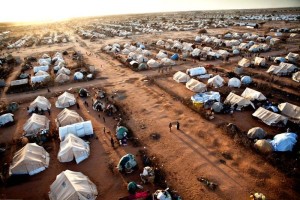World’s largest refugee camp under threat of closure

Dadaab refugee camp. Photo credit: World Food Programme
The world’s largest refugee camp is under threat of closure after the Kenyan Government cited it as ‘a nursery for al-Shabaab’ – the terror group that slaughtered 147 students at Garissa University on April 2.
The Kenyan government has called for the Dadaab camp, near the border with Somalia, to be closed but UN officials say dismantling the home of 350,000 people
will not happen quickly nor make the country safer.
This week Kenya’s deputy president William Ruto issued an ultimatum to the UN. He told the High Commissioner for Refugees (UNHCR) to shut down the camp within three months, or else Kenya would shut it down itself.
Officials have claimed that Dadaab is where al-Shabaab plans its acts of terror, such as Garissa and the 2013 Westgate Mall attack, and must be shut down.
“We have asked the UNHCR to relocate the refugees in three months, failure to which we shall relocate them ourselves,” said Ruto. “The way America changed after 9/11 is the way Kenya will change after Garissa… We must secure this country at whatever cost.”
But the UNHCR has urged Kenya to reconsider plans for closure of one of the world’s oldest and biggest complexes of refugee camps, and forcing its inhabitants back into Somalia.
The agency said such a forced repatriation would violate international law.
A quarter of a century old, Dadaab is the world’s oldest refugee camp, home to mostly Somali refugees who have fled famine, violence, and persecution in their home countries. The UNHCR estimates that “more than 350,000” people currently live there.
“Life isn’t easy in Dadaab. Jobs are scarce, food is minimal and healthcare is basic. But it’s also a safe haven, and its existence is celebrated as one of modern Kenya’s finest accomplishments,” UNHCR official said.
“That Dadaab has been able to provide refuge for so many years and to so many people is thanks first and foremost to the government and people of Kenya,” the spokesperson said.
Some fear that by using the 9/11 analogy means Kenya will prioritise internal security over human rights and civil liberties, suggesting the country will disregard its obligations under international law to house and protect refugees.
“The victims of the horrific attack in Garissa deserve justice which won’t be served by unlawfully forcing almost half a million Somali refugees back home to face a real risk to their lives and freedom,” said Leslie Lefkow, deputy Africa director at Human Rights Watch.
“Instead of scapegoating refugees, Kenya is legally obliged to protect them until it is safe for them to return, and should identify and prosecute those responsible for the killings in Garissa,” he said.
Laurie Nowell
AMES Senior Journalist












